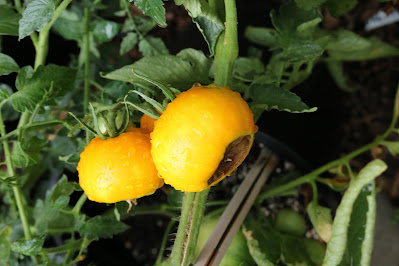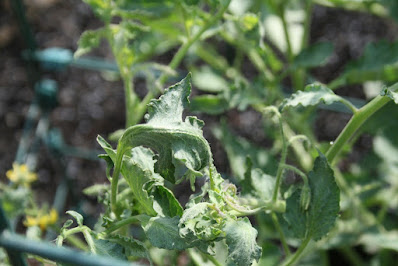When it comes to growing tomatoes, many factors can influence fruit quality and production. This is especially true following the second hottest June on record. Tomato plants do best when the daytime temperatures are between 65-degrees and 85-degrees Fahrenheit. When the daytime temperatures are consistently above 90-degrees Fahrenheit growth slows down, blossom set stops, existing fruit may fall, and leaves start to curl.
Your plants can still be productive if you practice good watering habits, remove weeds quickly, watch for and respond to diseases and insect activity, utilize mulch around the base of the plant, provide shade and avoid fertilizing when the temperatures are above 90-degrees Fahrenheit.
Best practices for watering tomatoes include a regular deep, thorough soaking at the base of the plant. Water slowly, allowing the water to soak in five or six inches. Avoid overhead watering, as this can cause disease problems. Water in the early morning, before eight.
Consistent moisture is critical, whether you’re growing tomatoes in beds or in pots. Blossom end rot is one of the most common problems with tomatoes. It appears as a dry, leather-like patch at the base of the fruit. This condition happens because of inconsistent watering which results in an uneven uptake of calcium. In addition to assuring a consistent source of water, a ready-to-spray calcium supplement can be applied directly on the fruit and leaves, using ferti-lome Yield Booster.
Concentrated Calcium is also available and can be applied as spray or added to the soil. Another option is to fertilize using an organic fertilizer that contains calcium.
Speaking of fertilizing, tomatoes need nutrients to produce the best fruit consistently. Happy Frog Tomato and Vegetable contains the right balance of Nitrogen, Phosphate and Potash to support the best fruit production. Just avoid fertilizing when the plant is under stress from high temperatures.
Other problems encountered this time of year include cat facing, zippering, late blight and insects.
When a tomato is malformed with misshaped groves, it’s called cat facing. Zippering appears as a scar resembling a zipper. Cat facing and zippering are disorders that occur early in the fruit formation cycle. There is no cure so the best thing to do is to remove any fruit that exhibit cracks or zippering.
Two major insects to watch for now include tomato horn worm and Western Flower Thrip. If you notice a sudden defoliation of your plant, accompanied by black droppings on the leaves, most likely there’s a tomato horn worm eating its way through your plants.
They’re very well camouflaged, but if you look carefully, you can find them and pick them off. Organic insecticides containing Bacillus thuringiensis (subspecies kurstaki) can be used safely and effectively to control horn worms.
If you notice leaves starting to curl, it’s often in response to the stress of high temperatures. The plant does this to reduce the surface area and slow down loss of moisture.
Leaf curl can also be the result of insect activity. If you start seeing stressed leaves and the fruit on your plant takes on a blotchy appearance, it’s almost certain your plants have Tomato Spotted Wilt Virus, a disease vectored by Western Flower Thrip. Spinosad is a good choice to control thrip.
Leaves can also curl up in response to herbicide damage, especially if the chemical 2-4d was used. Even the slightest amount of weed control products drifting onto tomato plants can cause cupping, twisting and distortion of the foliage. If this happens, prune off the damaged foliage. The plant will often recover.
Adding two to three inches of organic mulch around the base of the plant will stabilize the ground and reduce moisture loss. Soil Pep is a good choice because it can also be used to improve the soil your tomato plants are growing in.
Providing your plants with some shade will also help improve yields. When temperatures get above eighty-five to ninety degrees Fahrenheit, tomatoes on the vine won’t ripen. Temperatures this high will retard or prevent the production of the red pigment lycopene. Covering them with shade cloth will reduce the temperature and encourage fruit to set, as well as ripen.
When it comes to growing tomatoes, many factors can influence fruit quality and production. If you’re not sure what’s going on in your garden, bring a sample to The Flower Bin Diagnostic Center. We’ll figure out what’s going on and come up with solutions that will ensure you know what to do to get the best from your tomato plants.














No comments:
Post a Comment